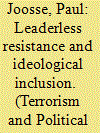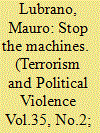|
|
|
Sort Order |
|
|
|
Items / Page
|
|
|
|
|
|
|
| Srl | Item |
| 1 |
ID:
172053


|
|
|
|
|
| Summary/Abstract |
Terrorists combining motivations and capabilities to conduct significant chemical, biological, radiological, or nuclear (CBRN) attacks are, logically and empirically, outliers. Certain characteristics of radical environmentalism heighten the risk of such outliers. The majority of even radical environmentalists embrace nonviolence. Those who turn violent mostly do so in limited ways due to a combination of motivations and capabilities. Fringe elements are motivated to commit large-scale—including CBRN—violence, but are mostly constrained by capability. Yet eco-radicalism also draws more capable adherents. If serious CBRN terrorism attacks occur—a risk about which analysts differ markedly—radical environmentalist fringe actors are plausible perpetrators.
|
|
|
|
|
|
|
|
|
|
|
|
|
|
|
|
| 2 |
ID:
080345


|
|
|
|
|
| Publication |
2007.
|
| Summary/Abstract |
Leaderless resistance is a strategy of opposition that allows for and encourages individuals or small cells to engage in acts of political violence entirely independent of any hierarchy of leadership or network of support. This article examines the development of the leaderless resistance strategy by the radical right and more recently by the radical environmentalist movement. While both movements use leaderless resistance to avoid detection, infiltration, and prosecution by the state, environmental groups like the Earth Liberation Front (ELF) benefit additionally because of the ideological inclusiveness that leaderless resistance fosters. Historically, ideological cleavages have rendered radical environmental groups such as Earth First! less effective than they would have been otherwise. Using leaderless resistance, however, the ELF eliminates all ideology extraneous to the specific cause of halting the degradation of nature. This elimination enables the ELF to mobilize a greater number of "direct actions
|
|
|
|
|
|
|
|
|
|
|
|
|
|
|
|
| 3 |
ID:
190955


|
|
|
|
|
| Summary/Abstract |
The Fourth Industrial Revolution promises to transform contemporary societies. Similarly, emerging technologies are affording countless new applications that assure an overall and widespread improvement of living standards. At the same time, their potential misuse has sparked concerns. In particular, the possibility of terrorist organizations adopting such technologies has dominated the scholarly debate. Consequently, there is a growing literature that deals with the motivational and technical factors potentially underlying the malevolent resort to emerging technologies. Enthusiasm for emerging technologies is, however, only one side of the coin. The last decade has, indeed, witnessed a re-emergence of forms of Neo-Luddism. Nevertheless, a thorough understanding of these developments is still lacking. This paper investigates and maps the main debates and dynamics in the Anti-Technology Movement in order to understand the rationale behind—and the prospects of—this resurgence. In doing so, it focuses on two radical fringes, namely the Insurrectionary Anarchist Milieu and the Radical Environmentalist Milieu. The paper argues that, although based on different narratives and end goals, these milieus share a similar commitment and operational approaches as well as a marked apocalyptic millenarian thinking that has set them on an escalatory path.
|
|
|
|
|
|
|
|
|
|
|
|
|
|
|
|
| 4 |
ID:
112618


|
|
|
|
|
| Publication |
2012.
|
| Summary/Abstract |
Despite concerns about the growing threat posed by domestic radical environmental and animal rights groups to the United States, there has been little systematic quantitative evidence depicting the characteristics of their attacks over time. In this paper we analyze data on 1,069 criminal incidents perpetrated by environmental and animal rights extremists from 1970 to 2007. Based on the Global Terrorism Database's definition of terrorism, we classified 17 percent of these incidents as terrorist. To supplement the analysis, we also conducted interviews with a nonrandom sample of twenty-five activists who self-identified as part of the environmental or animal rights movements. We find that overall, the attacks staged by radical environmental and animal rights groups thus far have been overwhelmingly aimed at causing property damage rather than injuring or killing humans. Further, results from our interviews suggest that activists appear to weigh carefully the costs and benefits of illegal protest. Despite the fact that attacks by environmental and animal rights groups have thus far been almost universally nonviolent, concerns linger that this situation might change in the future.
|
|
|
|
|
|
|
|
|
|
|
|
|
|
|
|
|
|
|
|
|